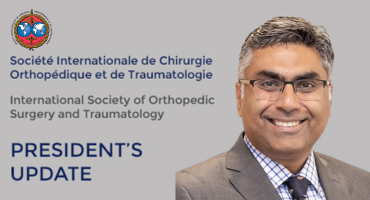
History of Orthopaedics
Discipline of Orthopaedia
 Bassel El-Osta Bassel El-OstaSICOT Associate Member & SICOT Newsletter Editorial Board Member - Tripoli, Lebanon |
In this article, I would like to write about what I love most: the discipline of orthopaedia. I was always curious, as a young surgeon, to find out where our discipline originated from and the evolution of the discipline until what it is today. There is a lot of information available, but I will summarise here the most interesting facts which influence our daily practice.
First of all, the word Orthopaedia was used for the first time as the title of a book published in 1741 by Nicolas Andry, Professor of Medicine at the University of Paris. Andry formed the word Orthopaedia out of two Greek words, orthos meaning straight, free from deformity and paidion, a child.
In the book a crooked young tree attached to a straight staff is depicted to exemplify his philosophy. This crooked tree became our symbol.
In the Middle Ages the deformed and the lame were ostracised from society and considered unfortunate incurables. A concern for the crippled developed gradually only after the radical philosophical and scientific revolutions that occurred during the Renaissance. The crippled were not considered a social problem until the 17th century. In 1601, England established the Poor Relief Act, the first statute enacted by a European government specifically mentioning the crippled and providing to some extent for their care. Thus, the crippled came into community consciousness as a public charge, and the medical profession gave its attention to the cure, prevention or relief of the lame and deformed body.
The orthopedists of the 17th and 18th century had a large body of knowledge on crippling deformities gathered by Greeks, Romans, and Renaissance physicians. The book by the School of Hippocrates on fractures and on articulations contains excellent discussions on the clinical aspects and treatment of fractures and dislocation.
In the 11th century, students from all parts of Europe went to Salerno where the study of anatomy was emphasised as an essential basis for surgical practice. From Salerno came Roger of Parma who wrote near the end of the 12th century the first great book on surgery in Western Medical Literature. In it is found much of the Greek material with little trace of Arabian influence. From Salerno, surgery moved up the Italian peninsula to the newly created University of Bologna in 1113. Bologna still ranks as a foremost centre of orthopaedic surgery. In Bologna, effective and simple braces were devised, such as spinal supports and splints for fractured femurs. Salice wrote in 1275 his important book on "Cyrurgia" which is considered to be the best work on anatomy before the Renaissance. Salice preferred the scalpel to the cautery and insisted upon cleanliness when operating and the avoidance, when possible, of trauma and manipulation. In Bologna the fundamental doctrine of antisepsis was taught as practised by the Hippocratic School as well as the avoidance of wound contamination.
Improved surgical techniques and applied bioengineering have changed the practice of orthopaedics in the past 50 years. Probably the most successful innovation has been the improvement of the hip arthroplasty with a total hip replacement designed by Professor John Charnley of the University of Manchester, England. Charnley replaced the head of the femur with a metallic prosthesis of small size to reduce the "moment" of frictional force. This prosthesis is used in combination with a low friction plastic socket. He developed a self-curing acrylic cement to anchor both the femoral replacement and the acetabular high-density polyethylene socket. In the developed countries, total hip replacement is used very often for the treatment of patients with osteoarthritis of the hip and other hip ailments. The operation has been very successful in providing pain relief and good hip motion for several years following surgery.
Internal fixation of the skeleton for treatment of fractures has been greatly perfected with the use of plates and screws and other devices made of inert metallic alloys. The three-phlanged nail devised in 1931 by Smith Petersen of Harvard represented an important advance in the treatment of fractures of the neck of the femur. Intramedullary nailing for fracture of the shaft of the femur with the Kuntscher nail was used extensively during World War II, and it is a successful method of treating femoral shaft fractures in clinical practice. Internal fixation of the shaft fractures interferes, however, with the natural fracture callus formation and delays the healing of fractures. In the hands of a good surgeon, internal fixation of articular fractures greatly improves the results. Internal fixation of fractures not involving the joints is possibly not better than the judicious application of plaster of Paris bandages which can successfully immobilise the injured extremity and allow for weight bearing and functional use of the injured extremity. Plaster of Paris, by the way, was first introduced by Mathijsen, a Flemish army surgeon, in 1852. Plaster of Paris successfully replaced traditional splints made of a mixture of egg white, gums, and resins.
This is a very short history of our discipline showing that it hasn't developed overnight and, as a lot of great professors will say, "there is a long way to go".














